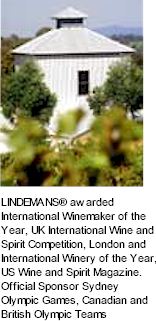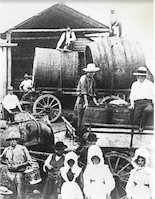


A graduate of London’s famous St. Bartholomew’s Hospital, Henry Lindeman discovered winemaking while travelling through Europe in the late 1830s. Fascinated by wine’s medicinal benefits, he devoted much of his time to learning the skilful craft. In 1840, he returned to England to marry Eliza Bramhall and within weeks, the couple embarked on a four-month voyage to start a new life in the Australian colonies.

Alarmed by the poisonous hard spirits of the early colonies, Henry Lindeman became even more devoted to the social and medicinal benefits of quality wine. With a successful medical practice behind him, he was soon able to turn his attention to winemaking and in 1843 he had planted his first vineyard on his 330-acre property Cawarra in the Hunter Valley. There, in the rich soils of the Paterson River flats, he planted Riesling, Verdelho and Shiraz grapevines and set about building a winery and cellar.
From the outset Henry Lindeman’s winemaking philosophy was to craft wines for everyday enjoyment. This meant cellaring wines and not releasing them for sale until they had properly matured so that consumers could enjoy the wines immediately. This philosophy soon earned Henry Lindeman a reputation for producing wines of the highest quality and in 1858 he began exporting Cawarra Claret to the United Kingdom. Throughout the 1860s Dr Henry Lindeman exhibited his wines extensively and by 1862 Cawarra gained international recognition at the 1862 International Exhibition in London and the 1867 Paris Exhibition.
Along with the winery and a successful medical practice, Henry and Eliza had ten children by 1863. Three of Henry and Eliza’s five boys joined their father in business in 1879. Like their father, Henry’s sons devoted much of their time to pioneering the art of blending wine, requiring much skill and patience to ensure consistent high quality wines from one year to the next. The three sons continued the family business and in 1882 Lindemans won its first major international award at Bordeaux for Cawarra Claret.

Under the leadership of Charles Lindemans, the company flourished and by 1888 there were seven cellars. In 1918 Charles Lindeman retired and his son Eric Lindeman took over the company. One hundred years after Dr Henry Lindeman planted his first vineyard in the Hunter Valley, the Lindemans Wine Company became a public listed company. The company once again flourished with this new injection of capital and vineyards were purchased in South Australia (Barossa Valley and Coonawarra) and another one was established (Padthaway).
Lindemans were amongst the first to bring Australian wines to the world. Lindemans Bin 65 Chardonnay was first crafted for the Canadian market and launched in 1985 in response to the popularity of the Lindemans style of wines in the northern hemisphere. Following its success in Canada and the United States, Lindemans Bin 65 was brought home to Australia in 1991.
Today, the Karadoc Winery in Victoria, established 1973 on a 163-hectare dairy farm near Mildura in the Sunraysia district, is the nerve-centre of the Lindemans brand. Karadoc crushed and produced its first vintage in 1974. Since inception the operation has employed a high level of automation and technical excellence. Bottling-on-demand and just-in-time delivery ensures that Lindemans wines are maintained at the highest possible level before leaving the watchful eye of the winemakers. Indeed, the winery adheres to strict quality standards.
One of the most modern winemaking facilities in the southern hemisphere, Karadoc is responsible for crushing, storing and packaging millions of litres of wine which pass through its doors every year. It is, in essence, the place that takes Lindemans to the world. From those humble first plantings in his Cawarra vineyard, Dr Lindemans has indeed brought pleasure to everyone making Lindemans the number one Australian wine brand in the world. As he said at the outset, "The one purpose of wine is to bring happiness!"
